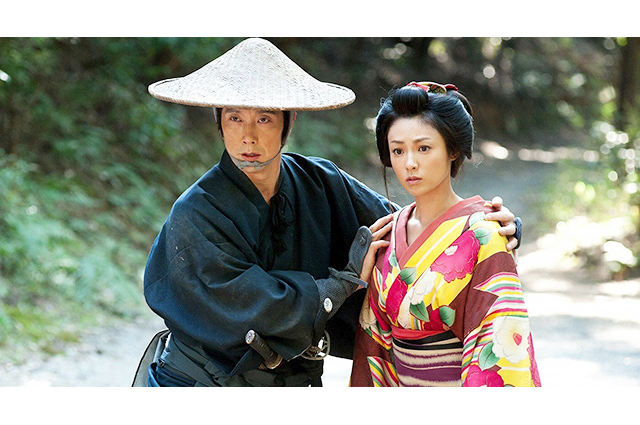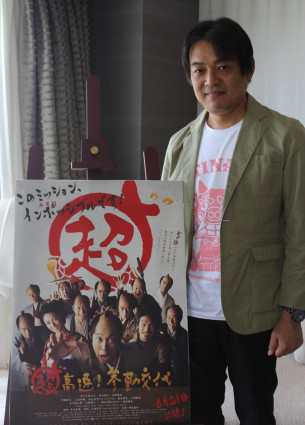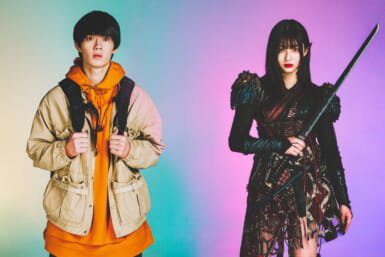The director talks about finding humor in Edo period politics.
By Christopher O’Keeffe
For non-Japanese history buffs, Sankin-kotai was a policy established by the Shogunate during the Edo period that required every daimyō, the feudal lords of the time, to spend at least part of the year in the nation’s capital. These lords were obliged to embark on a journey, flanked by loyal retainers in a long and winding procession, to greet the Shogun in Edo. “Action-comedy” may not be the first thing that springs to mind when considering this archaic practice, but it’s around this historic legislation that director Katsuhide Motoki bases his latest film. Chō kōsoku! Sankin kōtai (or Mission Impossible: Samurai as it will be known abroad) sees popular TV actor Kuranosuke Sasaki (20th Century Boys) in the starring role as the Daimyo Masatsu Naito, who is forced to leave his hometown and appear before the Shogun. The put-upon lord is, unfortunately, out of cash and cannot afford the extravagant procession and accompanying samurai required of his position. Added to his lack of money and men, the journey itself should take eight days but there are just four left until his court appearance. Faced with a scheming rival who’s out to thwart the good-natured leader in order to gain his title and land, Naito must call upon his most loyal men, along with a little help from mercenary ninja Danzo (Tsuyoshi Ihara, Letters to Iwo Jima) and feisty local girl Osaki (Kyoko Fukada, Dolls, Ringu 2), to get to the capital in time – or risk losing both his land and his head.
While this is the director’s first feature length samurai film, it’s hardly unfamiliar territory for the busy filmmaker. Motoki worked on the jidai-geki (samurai-drama) TV series Kamiya Genjirô Torimono Hikae, and has a back-catalogue of comedy features including 2004’s Drugstore Girl, the live-action versions of classic manga GeGeGe no Kitaro and last Christmas’s Japanese take on Love, Actually, It All Began When I Met You. During the Okinawa International Film Festival, the director sat down to talk about his latest feature.
“The sankin-kotai system was established by the Tokugawa government and continued for 300 years. There’s a comedy show that uses this Sankin-kotai system as a kind of challenge. It got me thinking about the system and why these things happened and I wanted to make a film exploring this. I read a lot of books on sankin-kotai, I did a lot of research, and I was very interested in the history and why they actually did this very stupid thing!”
This being the director’s first attempt at a staple genre of Japanese cinema since the early of days of filmmaking in the country, it seems reason able to assume it was the director’s dream to work in this long-established genre but it seems the directors reasons were more practical in nature, “I had been making a jidai-geki as a TV show (Kamiya Genjirô Torimono Hikae), but the genre has been losing its audience for some time and so I wanted to attempt to make a successful film. I always wanted to make comedy but ended up working in drama. I noticed that comedy films were really realistic and the reality of drama films had become boring so I wanted to mix the two.” Of his favorite filmmakers in this genre, the director cites Kawashima Yuzo, a director revered for his tragi-comedies, as his favorite, particularly his classic A Sun-Tribe Myth from the Bakumatsu Era.
Despite its comedy leanings, his movie focuses heavily on the timeless notion of the ‘samurai spirit’ and the value of living by a samurai code. There are often two sides to this lifestyle visible in samurai dramas: the positive traits of loyalty and respect, but also a negative side, that of mistreatment and cruelty of lower classes. How relevant does he think that these issues are today, and does this kind of thinking still offer relevant lessons for Japan’s youth?
“People have both sides to them and I wanted to describe all the inner aspects of people; it’s not just about respect and loyalty – there is weakness at the same time. Also beyond these traditional values I wanted to describe more important issues like the Tohoku earthquake: I wanted to ground it in more present themes.” The character of the ninja Danzo is archetypical of this type of drama, and of the westerns they would in many ways inspire. He is the highly skilled loner, roaming from town to town before disappearing into the sunset at the end of the movie. “Haha! I’d been watching Hollywood western films and they gave me inspiration on the Western style of jidai-geki. Danzo the ninja is getting older and his wife has left him, so I wanted to make a character who fights to get his life back again.”
Motoki learned the skills of his trade within Shochiku, one of Japan’s oldest and most established film studios. The idea of this film is speed and of getting somewhere fast, which mirrors the way that films today are being cut and edited together to make them faster and faster. Did this differ form his old-school studio upbringing? “Yes, that’s right, editing and shooting [have] become faster but when I was working at Shochiku, even for a low cost production I wanted to take things slowly, shot by shot. Right now the Japanese film industry is making films in the Hollywood style, taking two or three shots at the same time but I wanted to take care of the little things. For the major fight scene in the film, it took a lot of time and energy to make and even though I perhaps concentrated on a lot of possibly unnecessary things I wanted to take a lot of time to make it.”
Prior to working on his own films, the director worked as a producer on cult “Beat” Takeshi Yakuza flick Gonin, and it was several years before he was able to step behind the camera. “I started as an assistant director on Gonin.” I was not able to make it as a director but I worked as a producer and an assistant director, which was a very good experience. I worked for two years and then I started making comedy films because everybody said that if you can make good comedy films you can make any kind of films.”
And will the now-established filmmaker continue to work in his favored comedy genre? “Yes, that’s right. I’d like to work in all kinds of genres, except horror… well, maybe a zombie movie!”
Chô kôsoku! Sankin kôtai (Mission Impossible: Samurai) is in cinemas now.










